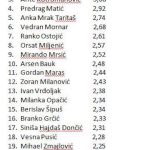April the 14th, 2023 – This week in Croatian politics, we’ve had to entertain the idea of Plenkovic potentially heading off for a very high position within NATO, calls to tackle the issues with the judiciary (again), leaked US documents have mentioned Croatia, and Franjo Tudjman took a tumble.
Foreign policy analyst Denis Avgadic talks Plenkovic, NATO, and issues with the Croatian judiciary
As Index writes, Croatian foreign policy analyst Denis Avdagic recently commented on the problems in the Croatian judiciary, the potential departure of Prime Minister Andrej Plenkovic to NATO, the ongoing war in Ukraine, protests raging in France, and the migrant crisis in Bosnia and Herzegovina and Italy on N1 television.
The Croatian judiciary
“I think it’s clear to everyone that the Croatian judiciary is the key cancer wound of this society and until we solve it, we’ll continue to be forced to deal with problems that are far beyond our ability to solve them. Let’s solve the issues with the Croatian judiciary first of all, and many things will become easier, more comfortable, and more efficiently as a result,” he said.
“I believe that the Croatian judiciary needs a reform of a wider scale. The judiciary as it is now is simply ineffective,” he added, noting that some cases are still being dealt with from the former state (Yugoslavia) and that this is utterly tragic.
Plenkovic could be heading off to NATO?
“The fact is that in European circles and a little more widely, Andrej Plenkovic is seen as a high quality member of staff, as a person who has certain diplomatic skills, quite extensive political experience, and as such he’s acceptable for a whole range of supranational functions. First of all, we in Croatia have been talking for a long time about whether Plenkovic is simply sitting and waiting for a higher position at the level of the European Union,” he pointed out.
“Looking at it from that aspect, it’s clear that there is speculation as to who could be an adequate replacement at the head of NATO,” he continued. He indicated the method of election of the head of NATO and that the bloc of new NATO members believes that the head of that alliance should be a person from that area who understands what Central and Eastern Europe has gone through what Ukraine is going through.
“Is Plenkovic a template person who would be responsible for that? Absolutely, yes, he is. Is Plenkovic a person who is acceptable to the whole bloc? Yes. Is he acceptable to the others? Absolutely. Is he acceptable to the Americans? Yes. Then we see why it occurred to someone to talk about him,” claimed Avdagic. He noted that Plenkovic is one of the leaders of the EPP.
“Plenkovic is a good candidate for the head of NATO”
He believes that Plenkovic could become the head of the European Commission, but pointed out that Plenkovic is a relatively young politician and therefore there’s no need for him to suddenly leave Croatian politics. Avdagic also emphasised that polls show that he could win another election right here in Croatia. “He’s one of those politicians who is a good candidate for the post of NATO chief,” he said.
A huge picture of Dr. Franjo Tudjman fell while Plenkovic was speaking
This was symbolism in motion in the eyes of many across the spectrum of Croatian politics as the first president of the independent Croatian nation almost cut Plenkovic’s speech short.
”Oh God, surely not?” Plenkovic said while turning to see the huge image of Tudjman falling from its place, seemingly also aware of the symbolism behind such an amusing event. Tudjman’s fall from grace as it were occurred precisely when a group of gathered journalists were asking him about Swedish media articles that had been circulating about him being among the candidates for the head of NATO, as I talked about above. Then the cameras turned to the wall where Tudjman is as the image fell down.
Politico claims that leaked secret US documents mention Croatia and Croatian helicopters
Europe has special forces on the ground in Ukraine, with Poland and Slovenia having provided almost half of the tanks delivered to Kiev. Neighbouring Hungary may also be releasing weapons through its airspace. These are just some of the striking details about European participation in the Russian-Ukrainian war from the 53-page document, based on leaked information from US military intelligence.
From precisely these leaked US documents, one can also learn something about the European war effort in Ukraine as a whole. The leaked files offer insight into everything from a British-dominated special forces group in Ukraine to how and when France and Spain will send a key missile system out into the battlefield. The documents also contain claims that Turkey is a potential source of arms for Russian mercenaries.
It’s important to note that Politico hasn’t independently verified the documents, and there are indications that some of the leaked pages are actually forged. That said, the USA has acknowledged the intelligence breach and arrested the suspect on Thursday. Here are some of Politico’s analyses after studying the dossier:
Europe allegedly has troops on the ground
According to the US documents, a European special forces group has been operating in Ukraine – at least since March the 23rd. The United Kingdom dominates the “US/NATO” contingent of 97 people with 50 members of its special forces. The group includes 17 people from Latvia, 15 from France and one from the Netherlands. There are also 14 American nationals.
As expected, national governments have been largely silent on the subject. The British declined to comment, while the White House admitted there was a “small US military presence” at the US embassy in Ukraine stressing that the troops were “not fighting on the battlefield”. The other countries listed did not respond to a request for comment.
Europe is providing most of the tanks to Ukraine
Tanks are one area in which Europe collectively outdoes America. One page gives an overview of the 200 tanks that US allies have promised to send to Ukraine – 53 less than what the document says Ukraine needs for its spring offensive. Poland and Slovenia appear to be the biggest contributors, accounting for almost half of the total number of tanks, according to an estimate as of February the 23rd. France and the United Kingdom are also key players, each with 14 tanks.
There is also the modern German Leopard 2 tank, which Ukraine has spent months convincing its allies it needs. This composition includes Germany, Norway, Portugal, Spain, Greece and Finland.
Croatia is also mentioned
Neighbouring Hungary appears several times in the leaked documents, which offers a lot of information about a country headed by Viktor Orban that regularly confuses its own allies. The most interesting tidbit of all in this sense is buried in a “Top Secret” CIA update dated March the 2nd, which says Hungarian Prime Minister Viktor Orban worryingly labelled the US as “one of his party’s three biggest adversaries” during a strategic policy session held in February this year.
These concerning remarks, the document points out, represent Orban’s “escalating level of anti-American rhetoric.” Indeed, Orban’s somewhat controversial government charted its own course during the war by pushing pro-Russian narratives, essentially calling on Ukraine to back down and strongly rejecting allied efforts to isolate the Russian economy and impose harsh sanctions on the Russian Federation.
However, the US documents also show that Hungary – which shares a small border with Ukraine – may be secretly allowing allies to use its airspace to move weapons towards the battlefield despite promises to ban such transfers. One of the leaked documents describes the plan of Ukrainian pilots to fly donated helicopters from Croatia to Ukraine in detail, and it also claims that will be done “through Hungarian airspace”. If this is indeed correct, the information shows not only that Hungary is releasing weapons through its skies but also contradicts media reports that the helicopters will be transferred by land or flights over Poland.
Hungarian and Croatian officials did not respond to any requests for comment.
Plenkovic says Eurozone and Schengen accession pushed Croatian growth forecasts above government expectations
Since Croatia’s official entry into the Eurozone and the Schengen area on the 1st of January this year, international institutions revised the growth expectations of the Croatian economy above the government’s GDP growth forecast for this year by 0.7 percent, Prime Minister Andrej Plenkovic said during the opening of a recently held government session.
He recalled the World Bank’s January forecast of 0.8 percent growth this year, which this month raised that same forecast to 1.3 percent, the European Commission announced in February that it expects Croatian GDP to grow by 1.2 percent, and the International Monetary Fund (IMF) estimated this year’s growth of the Croatian economy by 1.7 percent a few days ago.
“The impact of membership in the Eurozone and in Schengen will be felt in terms of growth”
“All of this means that they’re somewhat more optimistic than the forecasts that we ourselves projected, and I believe that the impact of membership in the Eurozone and the Schengen area will really be felt when it comes to domestic economic growth, which will be better than expected, despite the slowdown of the global economy in 2023,” said the Prime Minister.
He noted that according to Eurostat data, Croatia has reached 73 percent of the EU level of development, taking GDP per capita as a measure, which is the highest level so far, and in 2016, the country was at 62 percent. This means that Croatia is using its international position strongly and maximally, Plenkovic asserted. As for tourism, he predicts that this year’s summer season will be a record one. He also announced further government activity in preparations for loans from the National Recovery and Resilience Plan.
So far, as he explained, 2.2 billion euros have been paid to Croatia free of charge out of the 5.5 billion that are available, and the country has another 3.6 billion euros of loans available, with the government wanting to invest this money in education, renovation, energy efficiency, the water supply, transport, energy, gasification, etc.
For more on Croatian politics, make sure to follow our dedicated section. A Week in Croatian Politics providing an overview is published every Friday.











